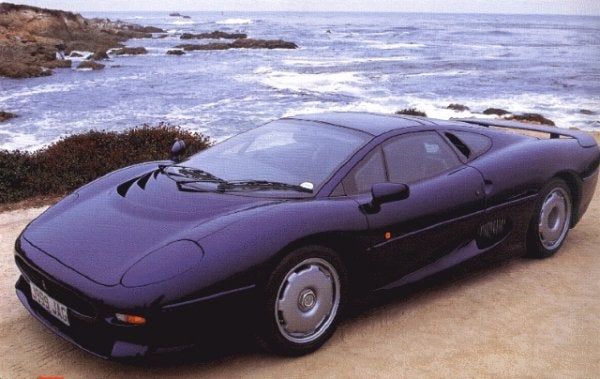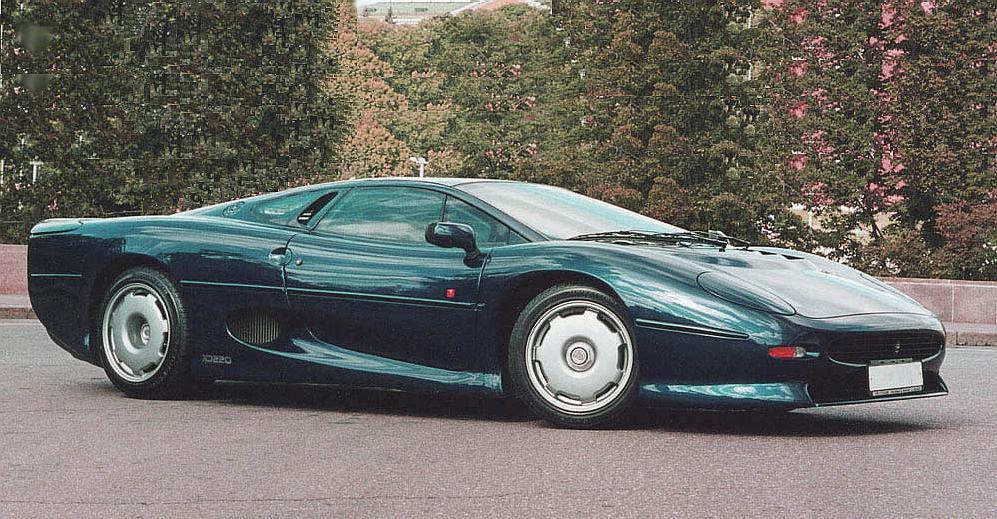Jaguar XJ220
The Jaguar XJ220 is a mid-engined supercar produced by Jaguar in collaboration with Tom Walkinshaw Racing as Jaguar Sport between 1992 and 1994. It held the record for the highest top speed of a production car (350 km/h, 217 mph) (although it was modified from standard to achieve this), until the arrival of the McLaren F1 in 1994. The XJ220 is unrelated to other XJ models, despite sharing the "XJ" prefix.Origins
n the early days of the company, certain Jaguar employees had created an informal group they called "The Saturday Club" (so-named because they would meet after-hours and on weekends to work on unofficial pet-projects). In the 1980s, Jaguar's chief engineer Jim Randle, as part of that group, began work on what he saw as competition for cars like the Ferrari F40 and Porsche 959. He envisioned what was essentially an updated XJ13 - a lightweight two-seater with a powerful mid-mounted V12 engine. Randle expanded on the idea by settling on all wheel drive for increased traction and better handling and an integral safety-cage so the car could be safely raced at extremely high speeds. From the outset, the intention was to create a vehicle capable of exceeding 320 km/h (200 mph).Concept car
Jaguar executives who saw the concept were sufficiently impressed to formally commit company resources to producing a car for the 1988 British Motor Show. Tom Walkinshaw Racing was engaged to produce a 6.2-litre version of Jaguar's V12 engine with four valves per cylinder, quad camshafts, and a target output of 500 hp (370 kW; 510 PS). The all-wheel drive system was produced by FF Developments, who had experience with such systems going back to the 1960s and the Jensen FF. The styling of the car was done by Keith Helfet and included scissor-style doors similar to those in use by Lamborghini in several of their cars. The name "XJ220" was assigned as a reference to the targeted top speed of 220 mph (350 km/h).The prototype car was significantly heavier at 1,560 kg (3,439 lb) than other Jaguar racers like the XJR-9. But as it was intended to be, first and foremost, a roadcar, it would be more appropriate to compare it with something like the XJS; in spite of being 30-inch (762 mm) longer and 10-inch (254 mm) wider and even with the added weight of the all-wheel drive system, the XJ220 was still 170 kg (375 lb) lighter than the XJS.
The car was officially announced in 1989 with a price of £361,000 ($580,000 USD) and prospective buyers were expected to put up a deposit of £50,000 ($80,000 USD) to be put on the waiting list for delivery. Because Jaguar promised to limit initial production to 220 units and that total production would not exceed 350, many of those who put deposits on the cars were speculators who intended to sell the car at an immediate profit.
Production version
The production version of the car was first shown to the public in October 1991 after undergoing significant changes. The most obvious of which was a completely different drivetrain and the elimination of the scissor doors. TWR was charged with producing the car and had several goals/rules: the car would be rear wheel drive instead of all wheel drive; would have a turbocharged V6 engine instead of the big V12; and performance goals of over 200 mph (320 km/h), 0 to 60 mph (97 km/h) in 3.6 seconds, and the lightest weight possible.The 6.2-litre V12 had been judged too difficult to get past increasingly strict emission regulations, and there were also reportedly some design problems caused by the size of the power plant. It was replaced with a Tom Walkinshaw-developed 3.5-litre V6 based on the engine used in the Austin Metro 6R4 rally car and fitted with twin Garrett T3 turbochargers, generating 542 bhp (404 kW; 550 PS) of maximum power at 7000 rpm and 476 lb•ft (645 N•m) of torque at 4500 rpm. This engine was the first V6 in Jaguar's history, and was the first to use forced induction. In spite of the smaller displacement and half the number of cylinders, the engine produced more power than the V12 would have. However, potential customers judged the exhaust note to be harsh and the lag from the turbos to be an annoyance. Also missing from the production version of the car was the Ferguson all wheel drive – the production car had only rear driven wheels, through a conventional transaxle – and the ABS.
With the promise of four-wheel drive and a 500bhp Jaguar V12 this sounded like a dream come true for enthusiasts and speculators alike. Unfortunately, when production finally began in the early 90s, the boom had gone and Group B (for which the XJ220 was originally conceived) had disappeared. Not only this but Jaguar had made the unpopular decision to drop the 4WD and V12 drivetrain for RWD and turbocharged V6. This led to disgruntled customers, many of whom launched court cases against Jaguar, only to lose, and ultimately unsold 220s.








Tidak ada komentar:
Posting Komentar